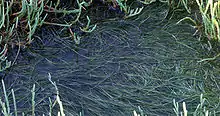Ruppia maritima
Ruppia maritima is an aquatic plant species commonly known as beaked tasselweed, ditch grass, tassel pondweed and widgeon grass,.[1] Despite its scientific name, it is not a marine plant; is perhaps best described as a salt-tolerant freshwater species.[2] The generic name Ruppia was dedicated by Linnaeus to the German botanist Heinrich Bernhard Ruppius (1689-1719) and the specific name (maritima) translates to "of the sea".
| Ruppia maritima | |
|---|---|
 | |
| Ruppia maritima | |
| Scientific classification | |
| Kingdom: | Plantae |
| Clade: | Tracheophytes |
| Clade: | Angiosperms |
| Clade: | Monocots |
| Order: | Alismatales |
| Family: | Ruppiaceae |
| Genus: | Ruppia |
| Species: | R. maritima |
| Binomial name | |
| Ruppia maritima | |
Distribution
It can be found throughout the world, most often in coastal areas, where it grows in brackish water bodies, such as marshes. It is a dominant plant in a great many shoreline regions. It does not grow well in turbid water or low-oxygen substrates.[3]
Description

Ruppia maritima is a thread-thin, grasslike annual or perennial[2] herb which grows from a rhizome anchored shallowly in the wet substrate. It produces a long, narrow, straight or loosely coiled inflorescence tipped with two tiny flowers. The plant often self-pollinates, but the flowers also release pollen that reaches other plants as it floats away on bubbles.[4]
The fruits are drupelets. They are dispersed in the water and inside the digestive system of fish and waterbirds that eat them.[4] The plant also reproduces vegetatively by sprouting from its rhizome to form colonies.[4]
Taxonomy and nomenclature
On the basis of molecular phylogenetic analyses, a species complex, named R. maritima complex, had been discerned,[5] which was then extended to include eight lineages,[6] or nine lineages.[7]
A lectotype for R. cirrhosa is designated and the name is shown to be a homotypic synonym of R. maritima.[8]
Wetlands and wildlife
This plant and the epiphytic algae attached to the floating leaves can be an important part of the diet for selected herivorous waterfowl species, but not important for predatory waterfowl that eat fish or invertebrate animals. In many areas, wetlands restoration begins with the recovery and protection of this plant.[9]
References
- English Names for Korean Native Plants (PDF). Pocheon: Korea National Arboretum. 2015. p. 614. ISBN 978-89-97450-98-5. Archived from the original (PDF) on 25 May 2017. Retrieved 24 December 2016 – via Korea Forest Service.
- Kantrud, H. A. (1991). Classification and Distribution - Wigeongrass (Ruppia maritima L.): A literature review. Archived 2009-09-14 at the Wayback Machine U.S. Fish and Wildlife Service.
- Kantrud, H. A. (1991). Habitat - Wigeongrass (Ruppia maritima L.): A literature review. Archived 2009-09-14 at the Wayback Machine U.S. Fish and Wildlife Service.
- Kantrud, H. A. (1991). Development and Reproduction - Wigeongrass (Ruppia maritima L.): A literature review. Archived 2009-06-06 at the Wayback Machine U.S. Fish and Wildlife Service.
- Ito Y., T. Ohi-Toma, J. Murata & Nr. Tanaka (2010) Hybridization and polyploidy of an aquatic plant, Ruppia (Ruppiaceae), inferred from plastid and nuclear DNA phylogenies American Journal of Botany 97: 1156-1167
- Ito Y., T. Ohi-Toma, J. Murata & Nr. Tanaka (2013) Comprehensive phylogenetic analyses of the Ruppia maritima complex focusing on taxa from the Mediterranean Journal of Plant Research 126: 753-762
- Ito, Y., T. Ohi-Toma, Nr. Tanaka, J. Murata, A.M. Muasya (2015) Phylogeny of Ruppia (Ruppiaceae) revisited: Molecular and morphological evidence for a new species from Western Cape, South Africa Systematic Botany 40: : 942-949
- Ito, Y., T. Ohi-Toma, C. Nepi, A. Santangelo, A. Stinca, N. Tanaka, & J. Murata (2017) Towards a better understanding of the Ruppia maritima complex (Ruppiaceae): Notes on the correct application and typification of the names R. cirrhosa and R. spiralis Taxon 66: 167-171
- Kantrud, H. A. (1991). Introduction - Wigeongrass (Ruppia maritima L.): A literature review. Archived 2009-09-14 at the Wayback Machine U.S. Fish and Wildlife Service.
External links
| Wikimedia Commons has media related to Ruppia maritima. |
